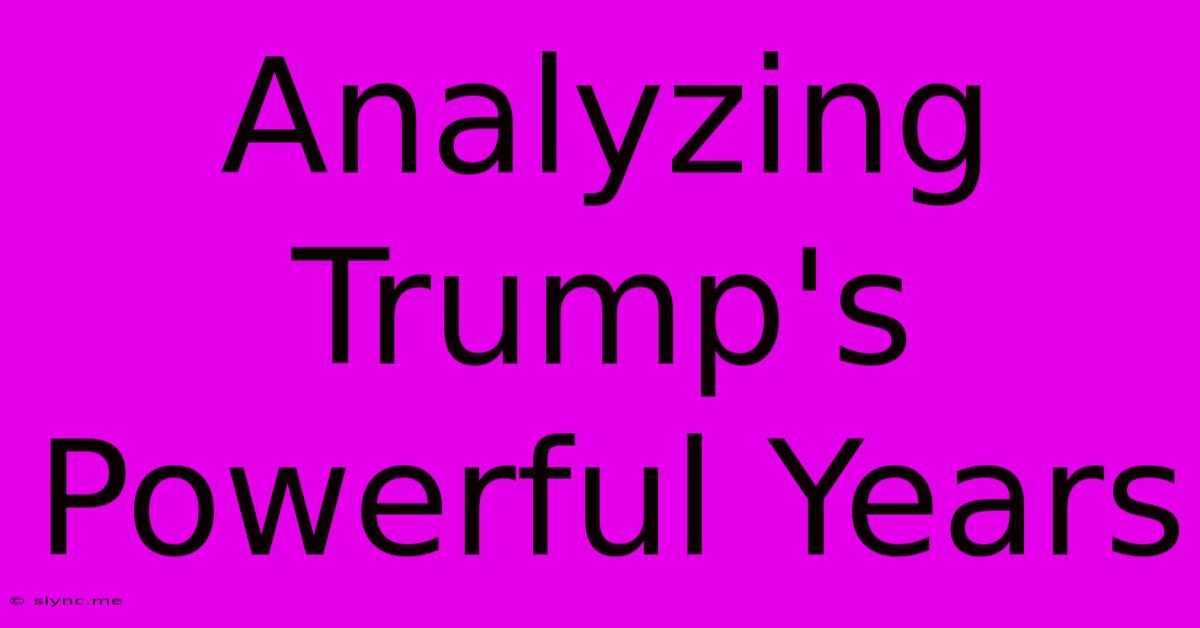Analyzing Trump's Powerful Years

Discover more detailed and exciting information on our website. Click the link below to start your adventure: Visit Best Website Mrs.Amykhan. Don't miss out!
Table of Contents
Analyzing Trump's Powerful Years: A Deep Dive into the 45th Presidency
Donald Trump's presidency (2017-2021) remains a highly debated and analyzed period in American history. His unconventional approach to politics, coupled with significant policy changes and a unique communication style, left an undeniable mark on the nation and the global stage. This analysis will delve into key aspects of his administration, examining both its successes and its controversies.
Economic Policies and Their Impact
One of the central pillars of Trump's platform was economic revitalization. He implemented significant tax cuts, aiming to stimulate economic growth through lower corporate and individual tax rates. The results were mixed. While the economy experienced a period of growth and low unemployment initially, critics point to rising national debt and a widening income inequality gap as potential downsides. Furthermore, the impact of the tax cuts on long-term economic health remains a subject of ongoing debate among economists. Analyzing the true effectiveness requires a multifaceted approach, considering factors beyond simple GDP growth.
Foreign Policy and International Relations
Trump's foreign policy was characterized by a departure from traditional multilateralism. He prioritized bilateral agreements, often challenging established alliances and international organizations. His withdrawal from the Trans-Pacific Partnership trade agreement and the Paris Agreement on climate change exemplified this approach. Simultaneously, he engaged in direct negotiations with North Korea and pursued a more confrontational stance towards China and Iran. The long-term consequences of these actions, including their effects on global stability and American influence, are still unfolding and warrant further scrutiny.
Social and Cultural Impacts
The Trump presidency witnessed significant social and cultural shifts. His rhetoric and policies sparked intense debates on issues such as immigration, racial justice, and LGBTQ+ rights. The appointment of conservative judges to federal courts, including the Supreme Court, had a lasting impact on the judiciary and the legal landscape. Furthermore, his frequent use of social media and direct communication with supporters reshaped political discourse, raising questions about the role of misinformation and polarization in the modern political climate. Analyzing the social impact necessitates examining shifting demographics, the rise of social media activism, and ongoing cultural tensions.
Controversies and Investigations
Trump's presidency was plagued by numerous controversies and investigations. These included allegations of Russian interference in the 2016 election, investigations into potential obstruction of justice, and questions surrounding his business dealings. The impact of these investigations on public trust and the legitimacy of his administration remains a key aspect of historical analysis. A thorough understanding requires evaluating the legal proceedings, examining the political fallout, and considering the lasting impact on American political institutions.
Conclusion: A Legacy in the Making
Analyzing the Trump presidency requires a nuanced and comprehensive approach. It's crucial to evaluate his policies and actions within their broader historical and political context, avoiding oversimplification or partisan bias. While some of his initiatives may have yielded positive results in specific areas, others sparked considerable controversy and long-term consequences. The ultimate legacy of the Trump era will continue to be debated and analyzed for years to come as historians and scholars delve deeper into the complexities of his time in office. Further research and investigation are crucial to fully understand the lasting impact of this transformative period in American history.

Thank you for visiting our website wich cover about Analyzing Trump's Powerful Years. We hope the information provided has been useful to you. Feel free to contact us if you have any questions or need further assistance. See you next time and dont miss to bookmark.
Also read the following articles
| Article Title | Date |
|---|---|
| Novi Vidklyuchennya Svitla Naslidki Ataki Rf | Dec 13, 2024 |
| Understanding Friday The 13th Fears | Dec 13, 2024 |
| New Witcher 4 Trailer 12 Facts | Dec 13, 2024 |
| Bezdoganna Gra Ukrayinets Trimaye Vorota Na Zamku V L Ch | Dec 13, 2024 |
| Repeated Poty Trumps Influence | Dec 13, 2024 |
